2014 AUDI TT ROADSTER ignition
[x] Cancel search: ignitionPage 122 of 244
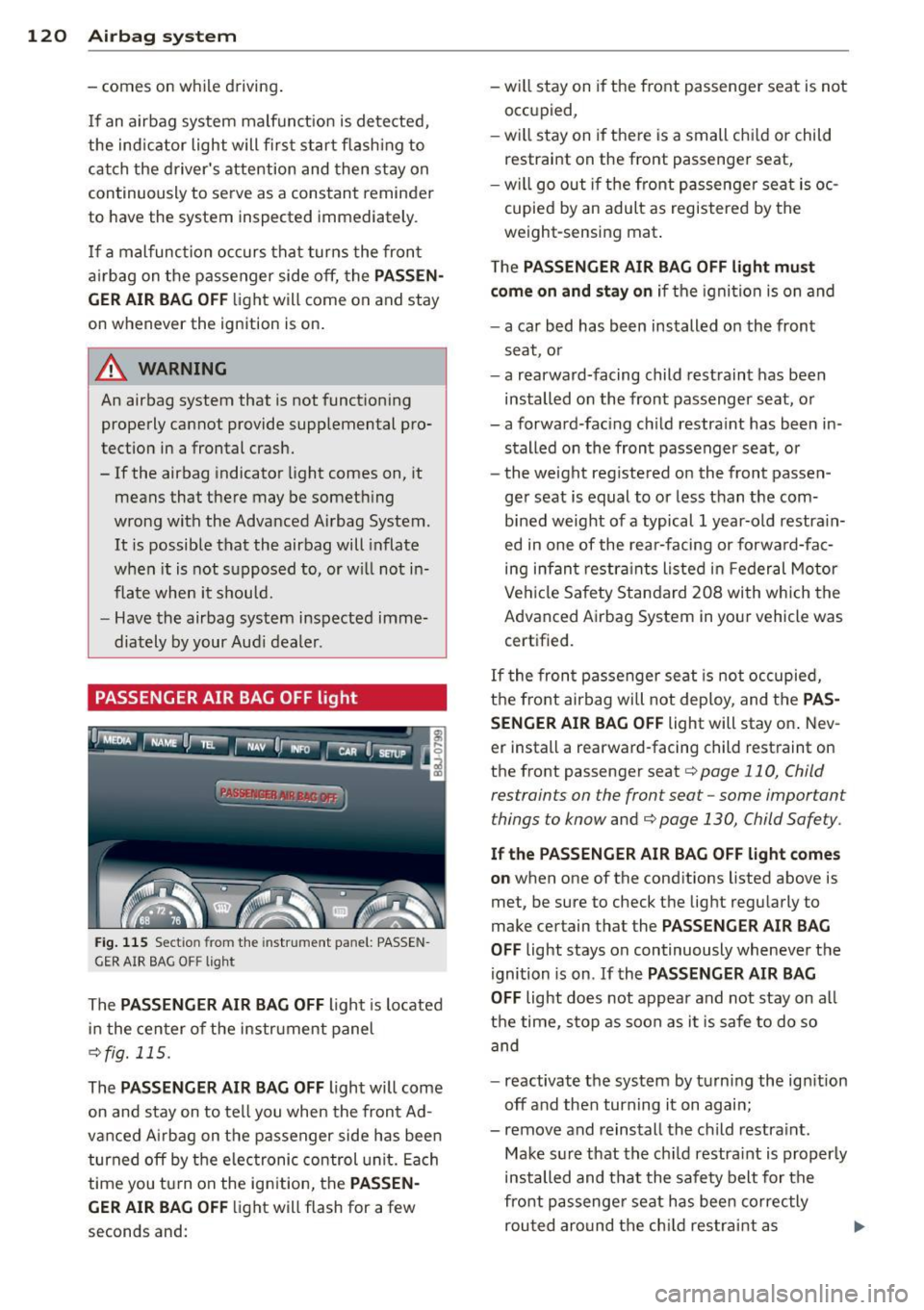
120 Airbag system
-comes on whi le driving .
I f an airbag system malfunct ion is detected,
the ind icator light will first start flash ing to
cat ch the d river's attention and then stay on
continuously to serve as a constant reminder
to have the system inspected immediately.
I f a malfunc tion occurs that turns the front
a ir bag on the passenger side off, the
PAS SEN
GER AIR BAG OFF
light will come on and stay
on whenever the ignition is on .
.&_ WARNING
An airbag system that is not functioning
properly cannot provide supplemental pro
tection in a frontal crash.
- If the airbag indicator light comes on, it
means that there may be somet hing
wrong with the Advanced Airbag System.
It is possible that the airbag will inflate
when it is not supposed to, or w ill not in
flate when it should.
- Have the airbag system inspected imme
diat ely by your Aud i dealer .
PASSENGER AIR BAG OFF light
Fig. 11 5 Sect ion from the instrumen t pa nel: PASS EN
GER AIR BAG OFF light
The PASSENGER AIR BAG OFF light is located
in the center of the instr ument panel
¢ fig. 115.
The PAS SENGE R AIR BAG OFF light will come
on and stay on to tell you when the front Ad·
vanced A irbag on the passenger side has been
turned off by the e lectronic control unit. Each
time you tu rn on the ig nition, the
PASSEN
GER AIR BAG OFF
li ght will flash for a few
seconds and: -
will stay on i f the front passenger seat is not
occupied,
- wi ll stay on if there is a small ch ild or child
restrai nt on the front passenger seat,
- will go out i f the front passenger sea t is oc
cupied by an adult as registered by the
weight-sensing mat .
T he
PAS SENGER AIR BAG OFF light mu st
come on and stay on
if the igni tion is on and
- a car bed has been installed on the front
seat, or
- a rearward-facing child restraint has been
installed on the front passenger seat, or
- a forward -fac ing ch ild restra int has been in
stalled on the front passenger seat, or
- the we ight reg istered on the front passen
ger seat is equal to or less than the com·
b ined weight of a typical 1 year-old restra in
ed in one of the rear -facing or forwa rd-fac
ing infan t restr aints listed in Feder al Motor
Ve hicl e Safety Standa rd 208 with wh ich the
Advanced Airbag System in your vehicle was
certified .
If the front passenger seat is not occupied,
the front airbag will not dep loy, and the
PAS
SENGER AIR BAG OFF
light will stay on . Nev
er install a rearward-facing child restraint on
the front passenger seat ¢
page 110, Child
restraints on the front seat -some important
things to know
and¢ page 130, Child Safety.
If the PASSENGER A IR BAG OF F light come s
on
when one of the cond itions listed above is
met, be sure to check t he light regularly to
make certain that the
PASSENGER AIR BAG
OFF
light stays on continuously whenever the
ignition is on . If the
PASSENGER AIR BAG
OFF
light does not appear and not stay on a ll
t h e time, s top as soon as i t is safe to do so
and
- reactivate the system by t urning the ig nition
off and then turning it on again;
- remove and reinstall the child restra int .
Make s ure that the ch ild restra int is properly
installed and that the safety belt for the
fro nt passenge r seat has bee n correctly
rou ted aro und the ch ild restrai nt as
Page 124 of 244
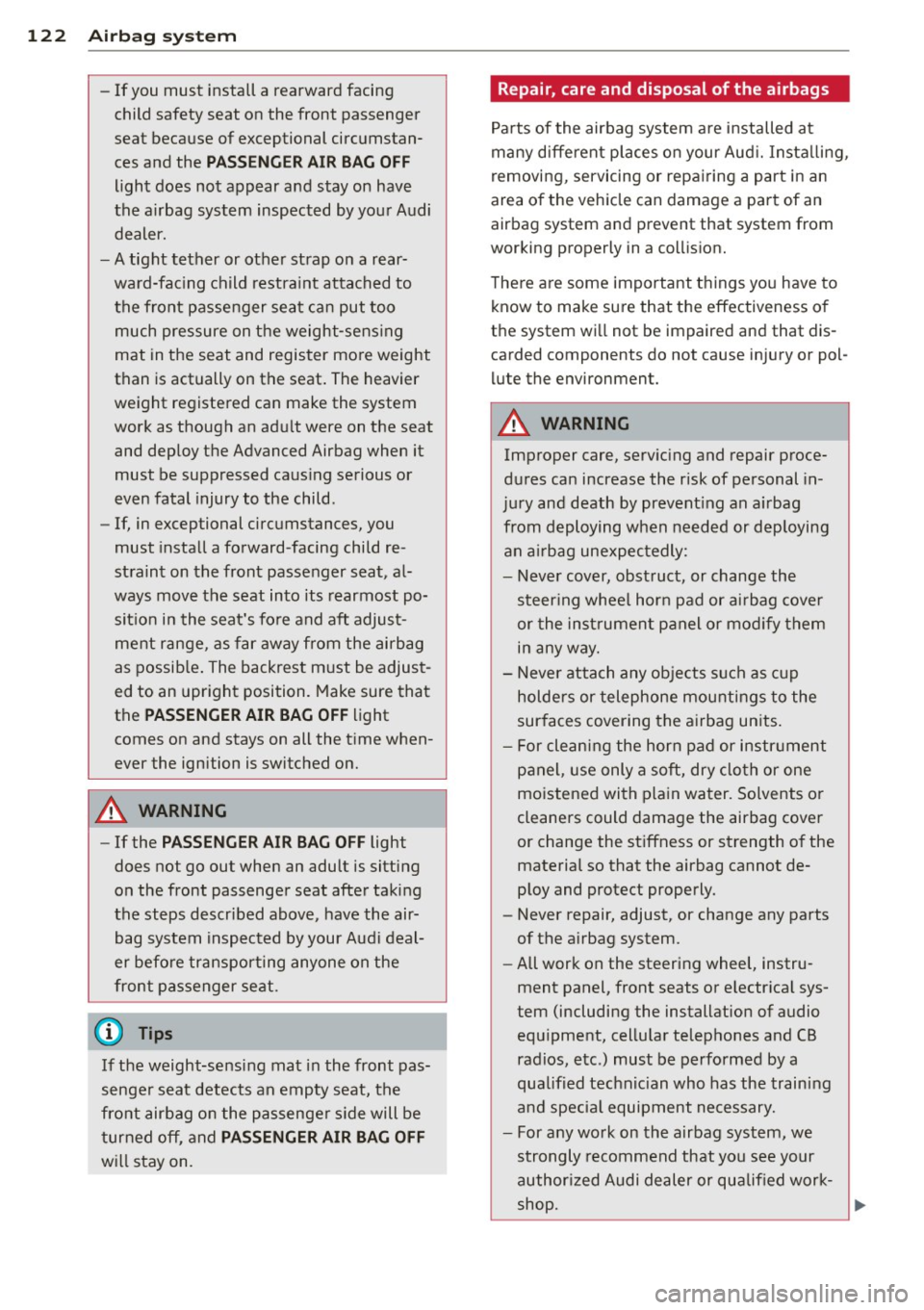
122 Airbag sys te m
- If you must install a rearward facing
child safety seat on the front passenger
seat because of exceptional circumstan ces and the
PA SSEN GE R AIR BA G OFF
light does not appear and stay on have
the a irbag system inspected by your Audi
dealer.
- A tight tether or other strap on a rear
ward-fac ing child restra int attached to
the front passenger seat can put too much pressure on the weight-sens ing
mat in the seat and register more weight
than is actually on the seat. The heavier
weight registered can make the system
work as though an adu lt were on the seat
and deploy the Advanced Airbag when it
must be suppressed caus ing serious or
even fatal injury to the child.
- If, in exceptional circumstances, you
must install a forward-facing child re
straint on the front passenger seat, al
ways move the seat into its rearmost po sit ion in the seat's fo re and aft adjust
ment range, as far away from the airbag
as possib le . The backrest m ust be adjust
ed to an upright position. Make sure that
the
PASSENGER AIR BAG OFF light
comes on and stays on all the t ime when
ever the ignition is switched on.
A WARNING
- If the PASSENGER AIR BAG OFF light
does not go out when an adult is sitting
on the front passenger seat after taking
the steps described above, have the air bag system inspec ted by your Audi deal
er before transporting anyone on the
front passenger seat.
(D Tips
If the weight-sensing mat in the front pas
senger seat detects an empty seat, the
front airbag on the passenge r side will be
turned off, and
PASSENGER AIR BAG OFF
w ill stay on.
Repair, care and disposal of the airbags
Pa rts of the airbag system are i nstalled at
many diffe rent p laces o n your Aud i. Insta llin g,
removi ng, servicing or repa iring a part in an
area of the veh icle can damage a part of an
airbag system and prevent that system from
working properly in a coll is ion.
T he re a re some important t hings you have to
k now to make sure that the effectiveness o f
t h e system wi ll not be impaired and that dis
carded components do not cause injury or pol
l ute the environment.
A WARNING
Improper care, serv ic ing and repair proce
dures can increase the risk of personal in
j u ry and death by prevent ing an a irbag
from deploying when needed or dep loying
an a irbag unexpec tedly:
- Never cover, obst ruct, or change the
steer ing whee l horn pad or ai rbag cover
or the in st rument panel or mod ify them
in any way .
- Never attach any obje cts s uch as c up
holders or telephone mountings to the
sur faces covering the a irbag un its.
- For cle aning the horn pad or instr ument
panel, use only a soft, dry clo th or one
moistened with pla in water. Solvents o r
cleaners could damage the airbag cover
or change the st iffness or strength of the
material so that the airbag cannot de
p loy and protect properly.
- Never repair, adjust, or change any parts
of the a irbag system.
- All work on the steering wheel, instru
ment panel, front seats or e lectr ica l sys
tem (including the installation of audio
equ ipment, cellu lar telep hones and CB
radios, etc.) must be performed by a
qualified technic ian who has the training
and specia l equipment ne cessary.
- For any wo rk on the airbag system, we
strongly recommend that you see your
author ized Audi dealer or qualified work-
shop. ..,.
Page 127 of 244
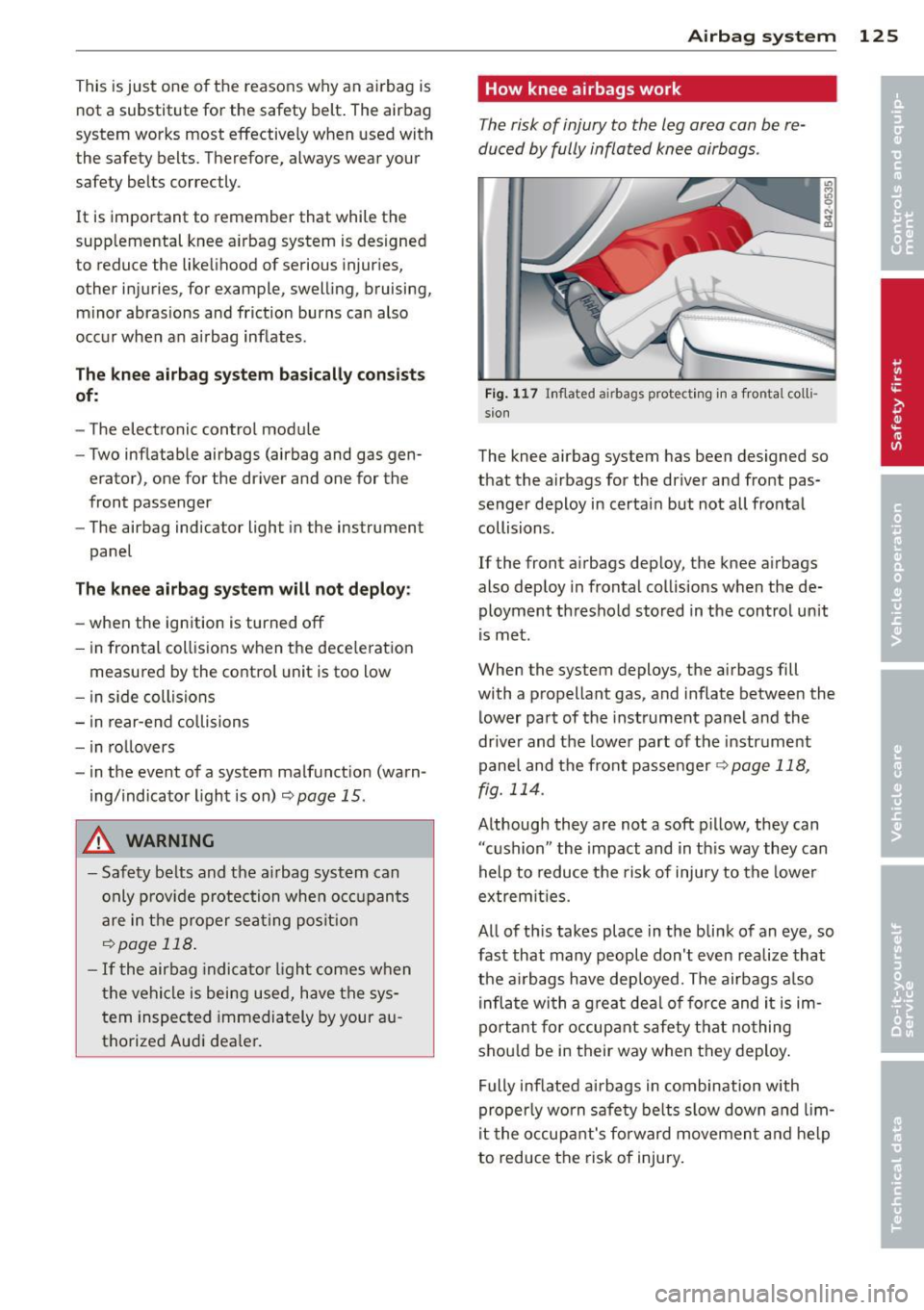
This is just one of the reasons why an airbag is
not a substitute for the safety belt . The airbag
system works most effective ly when used with
the safety belts. Therefore, always wear your
safety belts correctly .
It is important to remember that while the
supp lemental knee a irbag system is des igned
to reduce the like lihood of serious injuries,
other injuries, for example, swel ling, bruising,
minor abrasions and friction burns can also
occur when an a irbag inflates.
The knee airb ag sy stem ba sically con sist s
of:
-The electronic contro l modu le
- Two inflatable airbags (airbag and gas gen-
erator), one for the driver and one for the
front passenger
- The airbag indicator light in the instrument
panel
The knee airbag sy stem will not d eploy :
-when the ignition is turned off
- in frontal col lisions when the dece lerat ion
measured by the control unit is too low
- in s ide collisions
- in rear-end collisions
- in rollovers
- in the event of a system malfunct ion (warn-
ing/indicator light is on)~
page 15.
A WARNING
-Safety belts and the a irbag system can
o nly prov ide protection when o ccupants
are in the proper sea ting posit ion
~page 118.
-If the airbag indicato r light comes when
t h e vehicle is being used, have the sys
tem inspected immediately by your au
thorized Audi dea ler.
-
A irba g sy stem 125
How knee airbags work
The risk of injury to the leg area can be re
duced by fully inflated knee airbags .
Fig . 1 17 In flated a irbags protecting in a fronta l colli
sion
The knee airbag system has been designed so
that the airbags for the driver and front pas
senger deploy in certain but not all frontal
collisions .
If the front a irbags deploy, the knee a irbags
also deploy in frontal collisions when the de
ployment threshold stored in the control unit
is met .
When the system deploys, the airbags fill
with a propellant gas, and inflate between the lower pa rt of the instrument pa nel and the
driver and the lower part of the instrument
panel and the front passenger
9 page 118,
fig. 114 .
Although they are not a soft p illow, they can
"cushion" the impact and in th is way they can
help to reduce the risk of injury to the lower
extremit ies.
All of th is takes place in the blink of an eye, so
fast that many people don't even realize that
the a irbags have deployed. The airbags a lso
inflate wi th a great deal of fo rce and it is im
portant for occupant safety t hat no thing
shou ld be in their way when they deploy .
Fully inf lated ai rbags in combination with
properly worn safe ty be lts s low down and lim
it the occupant's forward movemen t an d help
to reduce the risk of injury.
Page 133 of 244

A WARNING
-=
If, in exceptional circumstances, you must
install a forward-facing child restraint on
the front passenger's seat:
- Always make sure the forward-facing
seat has been designed and certified by
its manufacturer for use on a front seat
with a passenger front and side airbag.
-Always follow the manufacturer's in
structions provided with the child safety
seat or carrier.
- Always move the passenger seat into its
rearmost position in the seat's fore and
aft adjustment range, as far away from
the airbag as possible before installing
the child restraint. The backrest must be
adjusted to an upright position.
- Always make sure that the
PASSENGER
AIR BAG OFF light comes on and stays
on all the time whenever the ignition is
switched on.
(D Tips
Always replace child restraints that were
installed in a vehicle during a crash. Dam
age to a child restraint that is not visible
could cause it to fail in another collision
situation.
Advanced front airbag system and children
Your vehicle is equipped with an "Advanced
Airbag System" in compliance with United
States Federal Motor Vehicle Safety Standard
(FMVSS) 208 as applicable at the time your
vehicle was manufactured.
The Advanced Airbag system in your vehicle
has been certified to meet the "low-risk " re
quirements for 3- and 6-year old children on
the passenger side and small adults on the
driver side. The low risk deployment criteria
are intended to reduce the risk of injury
through interaction with the airbag that can
occur, for example, by being too close to the
steering wheel and instrument panel when
the airbag inflates. In addition, the system
Child Safety 131
has been certified to comply with the "sup
pression" requirements of the Safety Stand
ard, to turn off the front airbag for infants up
to 12 months who are restrained on the front passenger seat in child restraints that are list
ed in the Standard .
Even though your vehicle is equipped with an
Advanced Airbag system, a child should al
ways ride in the seat properly restrained for
its age and size . The airbag on the passenger
side makes the front seat a potentially dan
gerous place for a child to ride. The front seat
is not the safest place for a child in a forward
facing child safety seat .
It can be a very dan
gerous place for an infant or a larger child in a
rearward-facing seat.
Advanced Airbags and the weight
sensing mat in the front seat
The Advanced Airbag System in your vehicle
detects the presence of an infant or child in a
child restraint on the front passenger seat us
ing the weight-sensing mat in the seat cush
ion and the sensor below the safety belt latch
on the front passenger seat that measures the
tension on the safety belt.
The weight-sensing mat measures total
weight of the child and the child safety seat
and a child blanket on the front passenger
seat. The weight on the front passenger seat
is related to the design of the child restraint
and its "footprint", the size and shape of the
bottom of the child restraint as it sits on the
seat. The weight of a child restraint and its
"footprint" vary for different kinds of child re
straints and for the different models of the
same kind of child restraint offered by child restraint manufacturers.
The weight ranges for the individual types,
makes and models of child restraints that the
NHTSA has specified in the Safety Standard
together with the weight ranges of typical in
fants and typical 1 year-old child have been
stored in the control unit of the Advanced Air
bag System. When a child restraint is being
used on the front passenger seat with a
ll-
•
•
Page 135 of 244
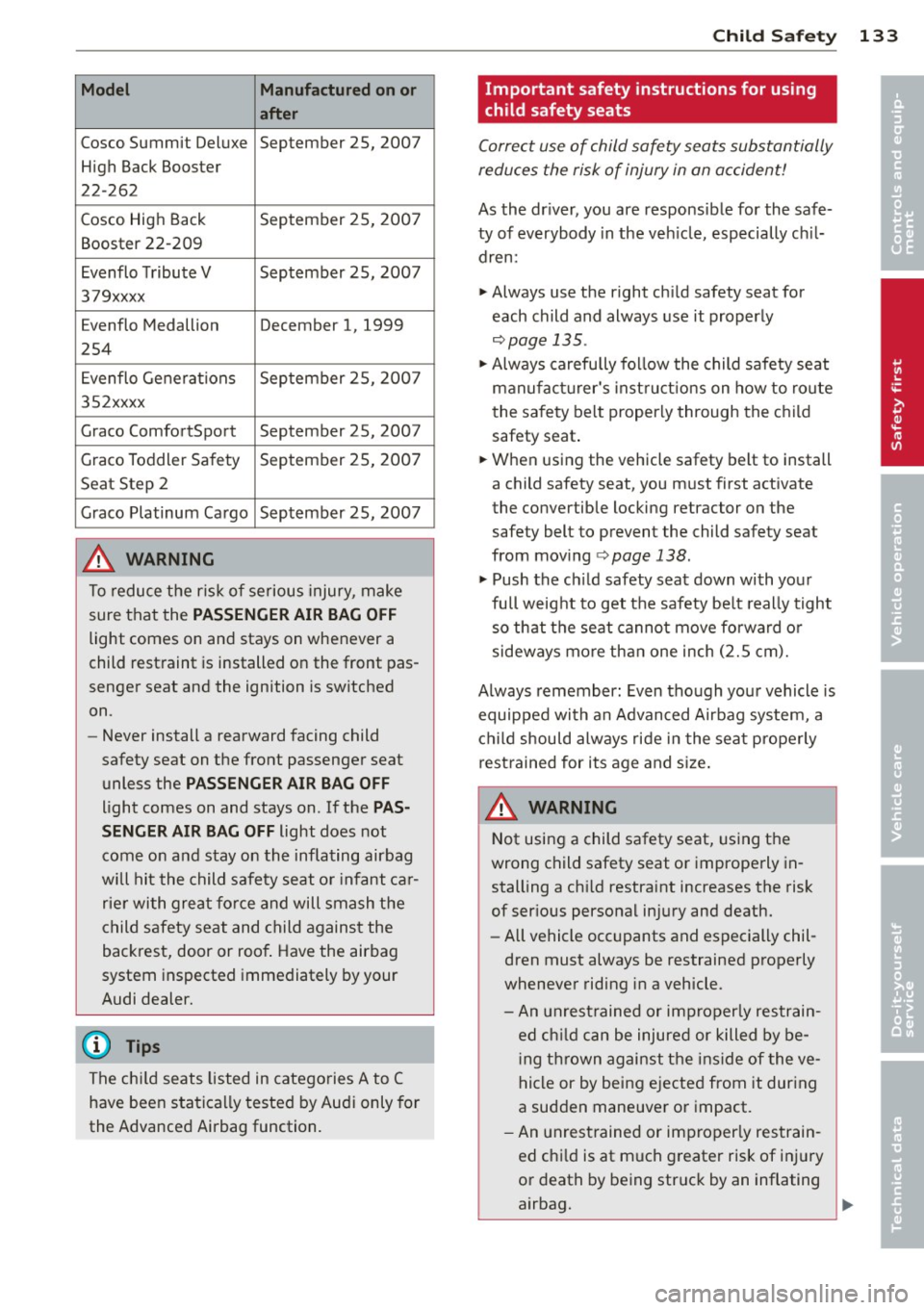
Model Manufactured on or
after
Cosco Summit Deluxe September 25, 2007
High Back Booster
22-262
Cosco High Back September 25, 2007
Booster 22-209
Evenflo Tribute V September 25, 2007
379xxxx
Evenflo Medallion December 1, 1999
254
Evenflo Generations September 25, 200 7
352xxxx
Graco ComfortSport September 25, 2007
Graco Toddler Sa fety September 25, 2007
Seat Step 2
Graco Platinum Cargo September 25, 2007
_& WARNING
To reduce the risk of serious injury, make
sure that the
PASSENGER AIR BAG OFF
light comes on and stays on whenever a
child restraint is installed on the front pas
senger seat and the ignition is switched
on.
- Never install a rearward facing child
safety seat on the front passenger seat
unless the
PASSENGER AIR BAG OFF
light comes on and stays on. If the PAS
SENGER AIR BAG OFF
light does not
come on and stay on the inflating airbag
will hit the child safety seat o r infant car
rie r wi th great force and will smash the
child safety seat and child against the
backrest, door or roof . Have the airbag
system inspected immediately by your
Audi dealer.
@ Tips
The ch ild seats listed in categories A to C
have been statically tested by Audi only for
the Advanced Airbag function.
Child Sa fet y 133
Important safety instructions for us ing
child safety seats
Correct use of child safety seats substantially
reduces the risk of injury in an accident!
As the dr iver, you are responsible for the safe
ty of everybody in the veh icle, especially ch il
dren:
.. Always use the right child safety seat for
each child and always use it properly
r=;, page 135.
.. Always carefully fo llow the child safe ty seat
manufact urer's inst ruct ions on how to ro ute
the sa fe ty belt properly through the c hild
safety seat .
.. When using the vehicle safety belt to install
a child safety seat, you must first activate
the convertible locking retractor on the
safety belt to prevent the child safety seat
from mov ing
¢ page 138.
.. Push the ch ild safety seat down with your
full weight to get the safety be lt really tight
so that the seat cannot move fo rward o r
sideways more th an one inch
(2.5 cm).
Always remember: Even tho ugh your vehicle is
equipped with an Advan ced Airbag system, a
ch ild should always ride in the sea t properly
restrained for its age and s ize .
_& WARNING ,-= ~
Not using a child safety seat, using the
wrong child safety seat or improperly in
stalling a ch ild restraint increases the risk
of ser ious personal injury and death.
- All vehicle occupants and especially chil
dren must always be restrained properly
whenever riding i n a vehicle.
- An unrest rained or imp roper ly restrain
ed ch ild ca n be injured or killed by be
i ng th rown against the ins ide of the ve
hicle or by being e jected from it during
a sudden maneuve r or impact.
- An unrest rained or improper ly res train
ed ch ild is at much greater risk of inj ury
or death by being struck by an inflating
airbag.
•
•
Page 136 of 244
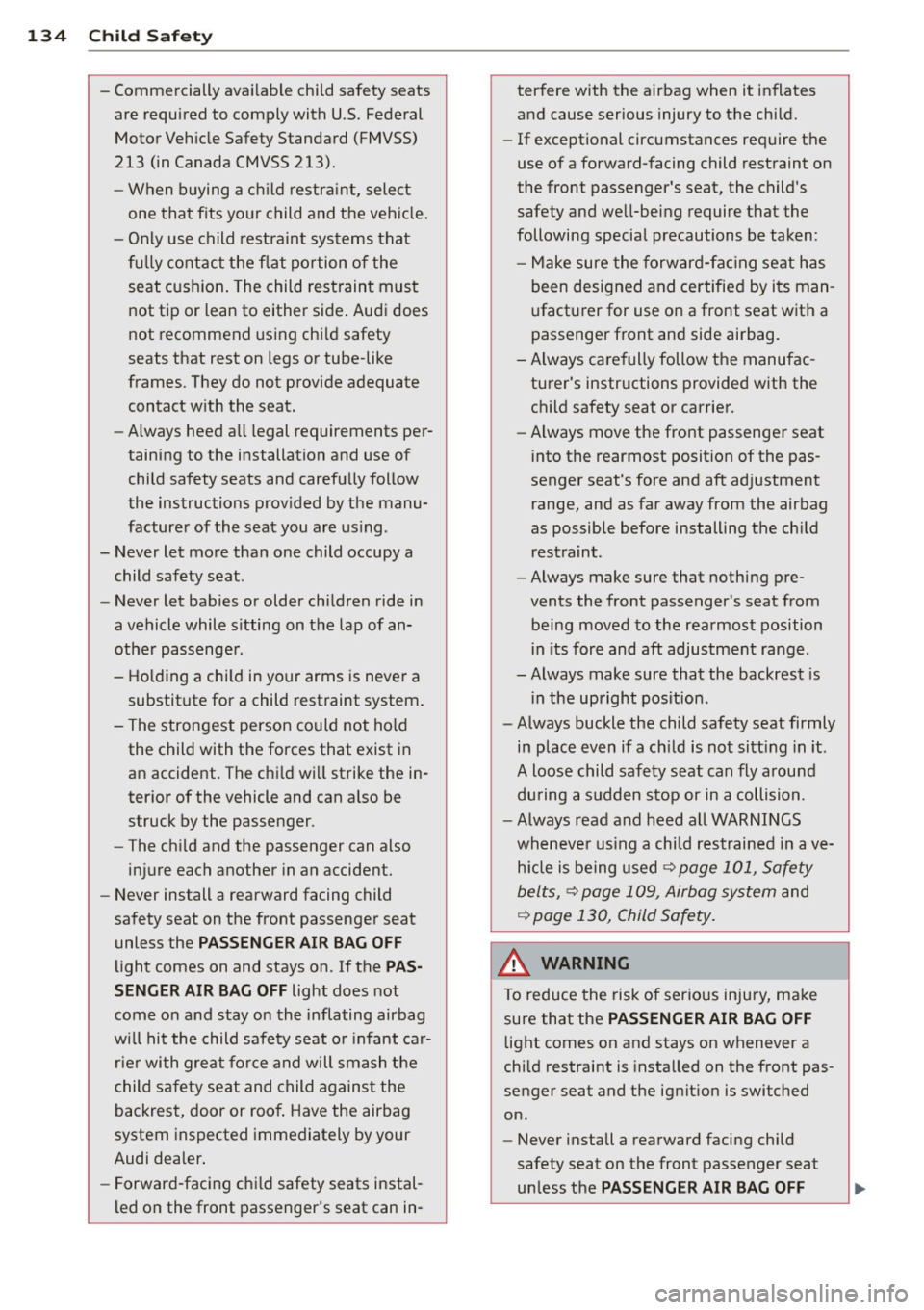
134 Child Safety
-Commercially available child safety seats
are required to comply with U.S. Federal
Motor Vehicle Safety Standard (FMVSS)
213 (in Canada CMVSS 213).
- When buying a child restraint, select
one that fits your child and the vehicle.
- Only use child restraint systems that
fully contact the flat portion of the
seat cushion. The child restraint must
not tip or lean to either side. Audi does
not recommend using child safety
seats that rest on legs or tube-like
frames. They do not provide adequate
contact with the seat.
- Always heed all legal requirements per
taining to the installation and use of
child safety seats and carefully follow
the instructions provided by the manu
facturer of the seat you are using .
- Never let more than one child occupy a child safety seat .
- Never let babies or older children ride in
a vehicle while sitting on the lap of an
other passenger .
- Holding a child in your arms is never a
substitute for a child restraint system.
- The strongest person could not hold the child with the forces that exist in
an accident. The child will strike the in
terior of the vehicle and can also be
struck by the passenger.
- The child and the passenger can also
injure each another in an accident.
- Never install a rearward facing child
safety seat on the front passenger seat
unless the
PASSENGER AIR BAG OFF
light comes on and stays on . If the PAS
SENGER AIR BAG OFF
light does not
come on and stay on the inflating airbag
will hit the child safety seat or infant car
rier with great force and will smash the
child safety seat and child against the
backrest, door or roof. Have the airbag
system inspected immediately by your
Audi dealer.
- Forward-facing child safety seats instal
led on the front passenger's seat can in- terfere with the airbag when it inflates
and cause serious injury to the child.
- If exceptional circumstances require the
use of a forward-facing child restraint on
the front passenger's seat, the child's
safety and well-being require that the
following special precautions be taken :
- Make sure the forward-facing seat has
been designed and certified by its man
ufacturer for use on a front seat with a
passenger front and side airbag.
-Always carefully follow the manufac turer's instructions provided with the
child safety seat or carrier.
- Always move the front passenger seat
into the rearmost position of the pas
senger seat's fore and aft adjustment
range, and as far away from the airbag
as possible before installing the child
restraint .
- Always make sure that nothing pre
vents the front passenger's seat from
being moved to the rearmost position
in its fore and aft adjustment range .
-Always make sure that the backrest is
in the upright position .
- Always buckle the child safety seat firmly
in place even if a child is not sitting in it.
A loose child safety seat can fly around
during a sudden stop or in a collision.
- Always read and heed all WARNINGS
whenever using a child restrained in ave
hicle is being used
¢ page 101, Safety
belts,
¢ page 109, Airbag system and
¢ page 130, Child Safety.
A WARNING
-To reduce the risk of serious injury, make
sure that the
PASSENGER AIR BAG OFF
light comes on and stays on whenever a
child restraint is installed on the front pas
senger seat and the ignition is switched
on.
- Never install a rearward facing child
safety seat on the front passenger seat
unless the
PASSENGER AIR BAG OFF
Page 140 of 244
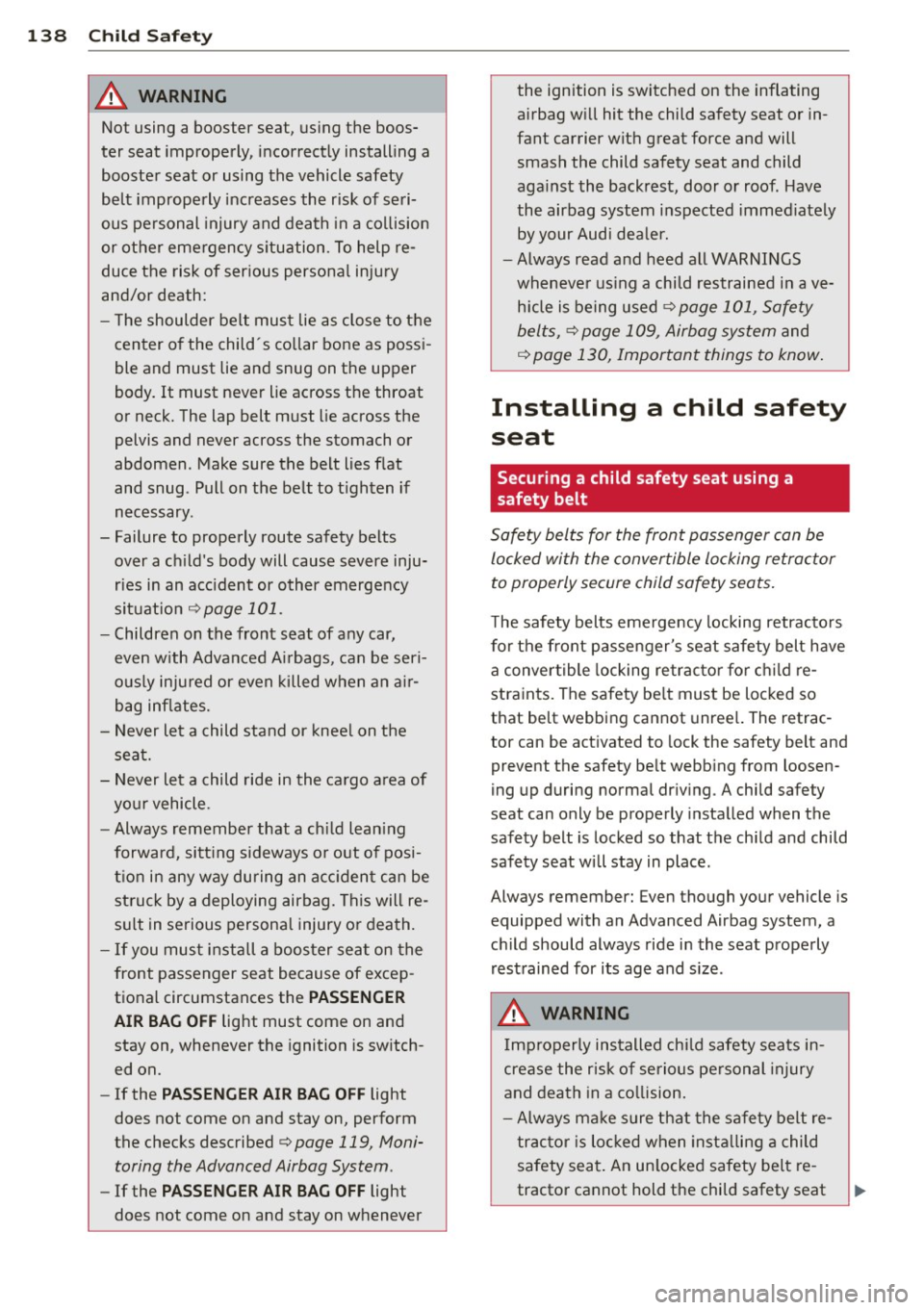
138 Child Saf ety
,8. WARNING
Not using a booster seat, using the boos
ter seat improperly, incorrectly install ing a
booster seat or using the vehicle safety
belt improperly increases the risk of seri
ous personal injury and death in a collision
or other eme rgency s ituation. To help re
duce the risk of serious persona l injury
and/or death:
- T he shoulder belt must lie as close to the
center of the child· s collar bone as possi
ble and must lie and snug on the upper
body. It must never lie across the throat
or neck. The lap belt must lie across the
pelvis and never across the stomach or
abdomen . Make sure the belt lies flat
and snug . Pull on the belt to t ighten if
necessary .
- Failure to properly route safety belts over a ch ild's body will cause severe inju
ries in an acc ident or other emergency
situation
¢ page 101 .
-Children on the front seat of any car,
even with Advanced A irbags, can be seri
ous ly inju red or even killed when an a ir
bag inflates.
- Never let a child stand or knee l on the
seat.
- Never let a child ride in the cargo a rea of
yo ur vehicle.
- Always remember that a ch ild lean ing
forward, sitting sideways or out of posi
t ion in any way during an acc ident can be
struck by a deploying airbag. This will re
sult in serious personal injury or death.
- If you must install a booster seat on the
front passenger seat because of excep
tional circumstances the
PASSENGER
AIR BAG OFF
light must come on and
stay on, whenever the ignition is switch
ed on.
- If the
PASSENGER AIR BAG OFF light
does not come on and stay on, perform
the checks described
¢page 119, Moni
toring the Advanced Airbag System .
-If the PASSENGER AIR BAG OFF light
does not come on and stay on whenever
-
the ignition is switched on the inflating
airbag w ill hit the child safety seat or in
fant carrier with great force and will smash the child safety seat and child
aga inst the backrest, door or roof. Have
the airbag system inspected immed iately
by your Audi dea ler.
- Always read and heed all WARNINGS
whenever using a child restrained in ave
h icle is being used
¢page 101, Safety
belts,
¢ page 109, Airbag system and
¢ page 130, Important things to know .
Installing a child safety
seat
Securing a child safety seat using a
safety belt
Safety belts for the front passenger can be
locked with the convertible locking retractor
to properly secure child safety seats.
T he safety belts emergency locking retracto rs
for the front passenger's seat safety belt have
a convertible locking retracto r for child re
straints. The safety be lt must be locked so
that belt webbing cannot unreel. The retrac
tor can be activated to lock the safety belt and
prevent the safety be lt webbing from loosen
ing up during normal driving. A child safety
seat can only be properly installed when the
safety belt is locked so that the child and child safety seat wi ll stay in place .
Always remember: Even though your vehicle is
equipped with an Advanced Airbag system, a
child should always ride in the seat properly
restrained for its age and s ize.
,8. WARNING
Imp roperly installed chi ld safety seats in
crease the risk of serious personal injury
and death in a collision.
- Always ma ke sure that the safety belt re
tractor is loc ked when insta lling a child
safety seat . An un locked safety belt re -
tractor cannot hold the child safety seat ..,_
Page 141 of 244

in place during normal driving or in a
crash.
- Always buck le the child safety seat firmly
in place even if a child is not sitting in it.
A loose ch ild safety seat can fly around
dur ing a sudden stop or in a col lision
- The inflating a irbag w ill hit the child
safety seat or infant carrier w ith great
force and w ill smash the ch ild safety seat
and child against the backrest, door or
roof.
- Forward -fac ing ch ild safety seats or in
fant ca rr iers installed on the front pas
senger 's seat may inte rfe re with the de
ployment of the airbag and cause se rious
injury to the ch ild.
- Always read and heed all WARNINGS
whenever u sing a child rest rained in ave
hicle is being used~
page 130 . Special
precautions apply when installing a ch ild
safety seat on the front passenger seat
~ page 110, Child restraints on the front
seat -some important things to know.
A WARNING
-
Always take special precautions if you
must install a forward or rearward-facing
child restraint on the front passenger's
seat in except ional situat ions :
- Whenever a forward or rearward-facing
child restraint is installed on the front
passenge r seat, the
PASSENGER AIR
BAG OFF
light must come on and stay on
whenever the ignition is switched on.
- If the
PASSENGER AIR BAG OFF light
does not come on and stay on, perform
the checks described
~page 119, Moni
toring the Advanced Airbag System.
- If the PA SSENGER AIR BAG OFF light
does not come on and s tay on whenever
the ignition is switched on the inflating airbag will hit the child safety seat or in
fant carr ier with great force and wi ll
smash the ch ild safety seat and chi ld
against the backrest, door or roof. Have
the a irbag system inspected immediately
by your Audi dealer .
Child Safet y 139
-Improper installation of chi ld restraints
can reduce their effectiveness or even
prevent them from providing any protec
tion .
- An improperly installed ch ild restra int
can interfere with the airbag as it de ploys and seriously injure or even k ill the
child.
- Always carefully follow the manufactur
er 's instructions prov ided with the child
safety seat or carrier .
- Never p lace add itiona l items on the seat
that can increase the total weight reg is
tered by the weight-sensing mat and can cause injury in a crash.
A WARNING
Forward-facing child restraints:
- Always make sure the forward-facing
seat has been designed and certified by
its manufacture r for use on a front seat
with a passenger fron t and s ide a irbag.
- Never put the fo rward-facing child re
s traint up, against o r ve ry nea r the in
strument panel.
- Always move the passenge r seat into its
rearmost pos ition in the seat's fore and
aft adj ustment range, as fa r away from
the airbag as possible before installing
the forward-fac ing ch ild restraint . The
backrest must be ad justed to an upright
position.
- Make sure that the
PASSENGER AIR BAG
OFF
li ght comes on and stays on all the
time whenever the ignit ion is switched
on.
A WARNING
Rearward -facing child restraints:
- A child in a rearward-facing child safety
seat insta lled on the front passenger
seat will be seriously in ju red and can be
killed if the front airbag inflates -even
with an Advanced A irbag System .
- The inflating airbag will h it the ch ild
safety seat or infant carrier with great
force and will smas h the child safety seat .,. •
•